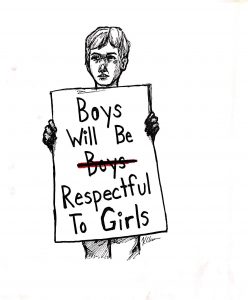
Editorial
Participating in the Pensacola Women’s March, the amount of diversity represented that day was impressive. It was clear that participants did not march solely for the rights of women, but for the rights of everyone.
People of color, the LGBT and newly added Queer, Intersex, and Asexual (QIA) community, immigrants, those of diverse faiths, people with disabilities, other minority groups and, yes, women showed up and showed out.
Naturally, females were not the only gender represented at the January event. Out of the thousands of people that attended, a good portion of the marchers were white, heterosexual males—not the typical idea of a “minority.” On the contrary, progressive, misogyny-shunning men are becoming somewhat marginalized through aggressive campaigning by extremists in the media.
Men showed up anyway, supporting a variety of causes including the reproductive rights of women. Definitively, a heartwarming sight was that many of the protest signs were held by young boys.
Seemingly, not all men are comfortable with “locker room talk,” nor should they be. Men flocked to the event to support their wives, daughters, sisters, and mothers. Some men marched to raise awareness that communities are made up of all kinds of people from all walks of life.
Contrary to the attempts of certain opposition groups, supporters weren’t just a bunch feminist man-hating revolters. Mothers, fathers, daughters, and sons all came together to recognize the importance of protecting the civil rights of all free people.
Learning how to interact with others, especially of the opposite sex begins at home for many of us. It is crucial that children of both sexes learn from a strong male and female role model how to be a respectful, responsible person. Increasingly important, young girls must be told from a safe male figure at an early age how valuable they are as an equal person.
The event wasn’t intended as a Women vs Trump or even Women vs Men protest. Messages from the event coordinators encouraged “an inclusive, intersectional, peaceful march” with a focus on comprehensive issues, not simply outrage. Organizers of the Pensacola march hoped to encourage unity and solidarity as the primary goals of this gathering.
Regardless of which side of the issue you land on, one unifying factor remains— we must make the world a better place for the next generations. Neither side really benefits from the nasty bitterness that taints political conversations at our schools, at our jobs, and even in our homes.
In all of the confusion and chaos, we must ultimately ask ourselves what do we want to pass on as the legacy? Hate and fear? Or compassion and understanding?

